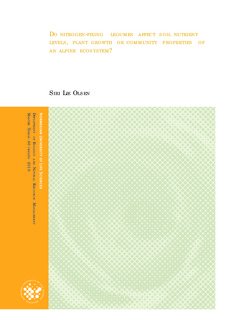Do nitrogen-fixing legumes affect soil nutrient levels, plant growth or community properties of an alpine ecosystem?
Master thesis
Permanent lenke
http://hdl.handle.net/11250/186722Utgivelsesdato
2011-04-27Metadata
Vis full innførselSamlinger
- Master's theses (INA) [593]
Sammendrag
In this master thesis I examine how two N-fixing legume species, Astragalus alpinus L. and
Oxytropis lapponica (Wahlenb.) Gay, affect different aspects of an alpine ecosystem in two
sites situated along a gradient in abiotic stress at Finse, Norway. The thesis consists of three
parts. In Part 1 I examine whether soil nutrient levels differ below and outside legumes. My results show that loss on ignition, total C and N content and NH4+-N and NO3--N levels were higher below than outside O. lapponica plants (but not A. alpinus), suggesting that O. lapponica may positively influence adjacent plants. In Part 2 I examine whether leaf density, size, growth rate, reproduction or N content of the alpine herb Thalictrum alpinum L. differ with and without the presence of legumes. I found that the leaf density of T. alpinum increased with both O. lapponica and A. alpinus, most likely due to increased clonal growth caused by elevated soil N levels. In Part 3 I examine whether species composition, species richness, species diversity or species evenness differ with and without the presence of legumes. I found that species composition differed and species richness increased with O. lapponica (but not A. alpinus), most likely due to increased N availability below the legumes. Altogether, Part 1-3 clearly show that O. lapponica has the ability to influence the alpine ecosystem at Finse. The legumes facilitate other species by increasing soil N levels, which not only increases the leaf density of a single target species, but cascades into community-wide effects altering species composition and increasing species richness.
